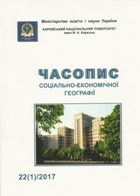Modern ukrainian diaspora in countries of former USSR
Abstract
In countries of the former Soviet Union concentrated almost half of the modern Ukrainian diaspora, particularly in theRussian Federationis home to the most numerous Ukrainian diaspora in the world. A reason of appearance Ukrainian diaspora in these countries was voluntary and forced migration, and inBelarus, theRussian FederationandMoldova- factor of state delimitation.
As a result of the census of population, which took place in the formerSoviet Unionafter 1989, established changes in the numerosity of Ukrainian diaspora and its settlement. Given the specificity of the countries that were part of the Soviet Union, can be identified there are four groups of countries: the Baltics, Central Asia and theCaucasus. The fourth group consists ofBelarus,RussiaandMoldova, where part of the Ukrainian diaspora are autochthonous population. Compared with other countries in the Baltics countries dynamics of decrease number of Ukrainians is lower. In spite of membership of these countries in the EU, processes of modern Ukrainian labor migration, Ukrainians are excluded from active political and public life in these countries.
InCentral Asiaafter 1989 found that the rate of decrease of Ukrainian diaspora very high because of low economic development, political situation in the region, Ukrainian integration into the Russian diaspora, natural decreases. InArmenia,GeorgiaandAzerbaijanbecause of military conflicts, revolutions and low living standards number of the Ukrainian diaspora is negligible. Beside this on the Ukrainian diaspora has influence linguistic, cultural and religious distance from the titular ethnic groups. InBelarus, the Ukrainian diaspora lives mainly inBrestregion and major cities. Ukrainian diaspora inMoldovais living mainly in the northern parts of the country and Transnistria. In theRussian Federationit is the Ukrainian ethnic territories and major cities, in which directed the flows of Ukrainian labor migrants. The reasons for reducing the number of Ukrainian diaspora were military conflicts, low life, and the unstable political situation that led to the re-emigration toUkraineor other countries. Among other reasons, it should be noted assimilation, a natural decrease in the number of Ukrainians.
Downloads
References
2. Bureau of National Statistica at Respublica Moldova. Available at: http://www.statistica.md.
3. Estonian Statistica. Available at: http://www.stat.ee.
4. Latvia Statistica. Available at: http://www.csb.gov.lv.
5. Lencyk-Pawliczko, A. (1994). Ukraine and Ukrainians throughout the World: a Demographic and Sociological Guide to the Homeland and Its Diaspora. University of Toronto Press, 509.
6. Lithuania Statistics Departament. Available at: http://www.stat.gov.lt.
7. Uzbekistan Respublic Statistic Committee. Available at: http://www.stat.uz.
8. Agency of President Tadjikistan. Available at: http://www.stat.tj/ru/population-census.
9. Vynnychenko, I.I. (1992). Ukraintsi v derzhavakh kolyshnioho SRSR: istoryko-geografichnyi narys [Ukrainians in countries of former USSR]. Lionok, 112.
10. State Statistics Committee of Turkmenistan. Available at: http:// www.stat.gov.tm.
11. Dnistryanskyi, M.S. (2008). Etnogeografiya Ukrainy [Ethnogeography of Ukraine]. Vydavnychyi tsentr LNU imeni Ivana Franka, 232.
12. Lazebnyk, S., Leshchenko, O., Makar, Ju. (1991). Zarubizhni ukraintsi [Ukrainians of abroad]. “Ukraina”, 352.
13. Zastavnyi, F.D. (1992). Skhidna ukrainska diaspora [Eastern Ukrainian Diaspora]. Svit, 176.
14. Zubyk, A.I. (2014). Etnogeografichni protsesy v seredovyshchi ukraintsiv Rosii [Ethnogeographical processes in Ukrainian diaspora in Russia]. Geografiya ta turyzm, 27, 199-209.
15. Zubyk, A.I. (2015). Ukrainska diaspora u krainakh Zakavkazzia: dynamika chyselnosti, osoblyvosti rozselennya [Ukrainian diaspora in Transcaucasian coutries: dynamic of number, features of resetlement]. Visnyk Kharkiv. un-tu. Ser. Geologiya. Geografiya. Ekologiya, 43, 113-118.
16. Kabuzan, V.M. (2006). Ukraintsy v mire: dinamika chislennosti i rasseleniya. 20-e gody XVIII veka –1989 god: formirovanie etnicheskikh i politicheskikh granits ukrainskogo etnosa [Ukrainians in the world]. M.: Nauka, 658.
17. Kazakstan Statistics Agency. Available at: http://www.stat.kz.
18. National Statistics Committee of Kyrgystan Republic. Available at: http://www.stat.kg.
19. National Statistics Committee of Belorus. Available at: http://www.belstat.gov.by.
20. National Statistics Service of Armenia. Available at: http://www.armstat.am.
21. National Statistics Office of Georgia. Available at: http://geostat.ge.
22. Troshchynskyi, V.P. (1999). Ukraintsi v sviti [Ukrainians in the world]. K.: Alternatyvy, 352.
23. Ukraintsi. Skhidna diaspora (atlas) (1993) [Ukrainians. Eastern Diaspora]. K.: Mapa LTD, 25.
24. Federal Service of State Statistics. Available at: http://www.perepis-2010.ru.
25. Ethnical atlas of Uzbekistan (2002) / pod red. A. Ilkhamova. Tashent: IOOFS-Uzbekistan, 452.
Copyright (c) 2017 Андрій Зубик, Дмитро Корнійчук

This work is licensed under a Creative Commons Attribution 4.0 International License.




